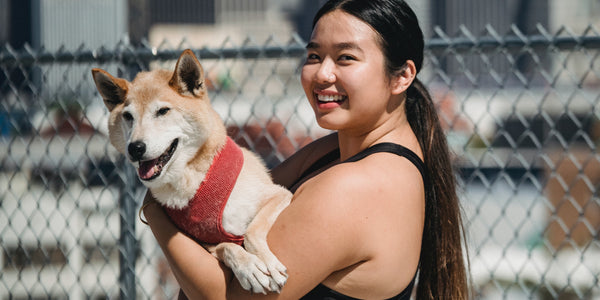Excessive shivering, change in appetite, hiding and lethargy — has your dog been showing any of the above behaviours recently? Just like humans, dogs can also suffer from anxiety. If you have asked yourself questions like why do dogs get anxiety, how do I know if my dog has anxiety, or how can I help my dog better deal anxiety, read on to find out more about anxiety in dogs!! Even though we have a lot of great tips in this article to help alleviate some of these behaviours, if your dog frequently exhibits signs of anxiety or abnormal behaviour, it is ideal to consult a licensed veterinarian for professional advice.
Why Do Dogs Experience Anxiety?
Anxiety can affect dogs of all breeds and ages. In addition, dogs can also become anxious or nervous for many reasons. Anxiety is especially common in dogs that have been rehomed, abandoned by their owners or have spent a lot of time in an animal shelter. These symptoms tend to arise due to the fear of abandonment, separation anxiety, travel, loud noises and meeting strangers. Thus, before you can start to treat your dog’s anxiety, it is first crucial to find the root cause.
Common Signs of Anxiety In Dogs
There are also many ways in which your dog can express anxiety. Some of the most common signs are:
- Excessive barking
- Shivering or trembling
- Whimpering, whining or crying
- Excessive howling
- Excess drooling or panting
- Depression or lethargy
- Aggressive behavior such as biting, growling etc.
- Restlessness such as pacing
- Excessive licking or grooming
- Potty accidents at home
- Repetitive behaviours such as scratching, chewing or digging
- Changes in appetite
- Hiding
Less Common Signs of Anxiety In Dogs
- Lip licking
- Showing the whites of their eyes
- Lifting of paws
- Avoiding eye contact
Dr Kate Mornment, an animal behaviourist from Australia, says that these subtle body language signs can signal mild signs of anxiety. These signs also serve as precursors to more serious anxiety. She mentions that if dog owners are able to pick up on these signs early, these symptoms are unlikely to further escalate.
Early Detection Of Anxiety In Dogs Is Key
Early intervention can help to better manage your dog’s anxiety issues. Dogs are unable to communicate their feelings. Hence, good observation of your dog’s behaviour is key. If at any point in time your dog shows sudden abnormal behaviour, do take him to see your family veterinarian for professional treatment.
Simple Tips: How to Manage Anxiety In Dogs
Developing a daily routine
A simple change in routine is sometimes what you need to put a stop to your dog’s anxiety.Dogs seem to thrive on consistency and regular routines. Therefore, by coming up with a proper daily routine schedule which sets out meal times, potty break times, time outside and playtime, it can help your dog will feel more occupied. Furthermore, it is also essential to bond and spend enough time with them so they do not feel lonely, neglected or abandoned. Just like humans, most dogs are social animals as well and do not enjoy being left alone. Hence, make sure your dogs get enough playtime and cuddle time!
Greater Physical Contact — More Cuddling
Physical contact is a vital part of your relationship with your dog and is also one of the best ways to reduce anxiety. If you notice that your dog is anxious, speak to them in a soothing tone and reach out to them physically. For example, you can give them a hug, pet them, cuddle with them on the sofa, or pick them up whenever possible. Doing all of these helps to remind them that they are loved and safe!
Ensure Your Dog Is Getting Enough Exercise
Most dog owners are unable to spend the entire day with their pet. However, it is possible to make your dog happier throughout the day just by exercising with them. When we exercise, endorphins are released. Similarly, these endorphins that stimulate happy, positive feelings in your dog also produced when they exercise! For example, you can take your dog out for a long walk, a jog or simply just play a long game of fetch. Just by exercising, the lasting effects of endorphins can go a long way in helping dogs with anxiety.
Use Music To Calm Them Down
Do you often find that listening to calming music helps reduce your anxiety? It also affects our pets the same way too! This is because music helps dogs who are sensitive to noise by muffling noise pollution from traffic, construction and other loud noises that might be affecting them.Recent studies done in dog shelters have shown that playing music reduces stress levels in dogs. As a result, the canines were found to have lower levels of cortisol (a stress hormone), calmer breathing and did not bark as often.
Hence, just by playing music while you’re home or on car rides, you can help to ease your dog’s travel anxiety. According to research, most canines seem to prefer music such as classical, reggae and soft rock. There is also music with species-specific frequencies that can help your dog calm down! Mixing in a variety of genres can further enhance the effects as well.
Massage Your Dog
Massages are a great way to help your dog to relax. This is because anxiety tends to cause muscles to become tense. Thus, dog massage is one of the best ways to help ease this tension, allowing your dog to feel more calm and relaxed. You can start with using long downwards strokes, working from the neck down. Next, massage your dog with one hand, while keeping the other on them in a calming manner. Furthermore, if you manage to locate some of their “trouble spots”, it would be good to focus more on those areas.
Nest Out A Cosy, Quiet Corner For Your Dog
Often, a “timeout” is used as a way to train your dog. However, when they are feeling anxious, leaving them in a quiet, enclosed and safe spot can actually help them to relax. Thus, it is great if can find an area in your house with dim lighting while you play some soothing music for them to listen to. The Petmate Vari Kennel Airline Approved Pet Carrier, is made with heavy duty coloured plastic shells, chromed wire doors, vents and plastic easy lock nuts with a door that can be left open for your dog to go in and out as and when he likes to for self-comfort.
(https://www.kohepets.com.sg/products/petmate-vari-kennel-pet-carrier)
Alternative Ways To Reduce Anxiety In Dogs
Many experts have suggested the following alternatives to help ease anxiety.
Calming Shirts/Coats
Calming coats and shirts are those that apply constant, mild pressure to your dog’s torso. Similar to swaddling a baby, calming shirts are suitable for dogs that suffer from anxiety when meeting strangers, traveling, and being separated from owners. For example, the ThunderShirt is one of the more popular choices among Singaporean dog owners.
(https://www.kohepets.com.sg/products/thundershirt-anxiety-relief-for-dogs)
Rescue Remedy For Pets
Rescue Remedy has been around for over 200 years and is part of the Bach Homeopathic Remedy line. This formula is perfectly safe for dogs and contains natural ingredients from flowers to help dogs feel less anxious. Therefore, it can be used to help soothe stress resulting from thunderstorms, travel, separation anxiety, new environments and more.Simply add a few drops to your dog’s water bowl or use the spray bottle to spray on surfaces such as your dog’s toys, clothing, and bedding!
(https://www.kohepets.com.sg/products/rescue-remedy-natural-stress-relief-for-pets)
Adaptil Home Diffuser
This home diffuser also helps calm your dog down, but by using aromatherapy! All you need to do is plug in the diffuser and subsequently, it will release pheromones similar to that of a female nursing dog. In addition, only your dog will be able to smell it and it has been proven safe and effective in reducing anxiety in dogs.
(https://www.kohepets.com.sg/products/adaptil-diffuser-with-vial)
Supplements
You can purchase chewable supplements like the VRS Tranquilium Emotional Balance Chewable Dog Supplements which has ingredients that help to ease anxiety and lower stress. For instance, some commonly found ingredients in anxiety-reducing products include: Melatonin, L-theanine & Jujube extract.
(https://www.kohepets.com.sg/products/vrs-tranquillium-emotional-balance-chewable-dog-supplement-30ct)
Treats
Some dog treats contain natural anxiety-reducing ingredients such as chamomile or valerian root. Thus, by consuming treats that have such calming properties, it can help your dog to feel less anxious!

(https://www.kohepets.com.sg/products/smartbones-smartsticks-calming-care-dog-chews-16pcs)
Seek Help If Your Dog is Displaying Abnormal Behaviour
It is essential to ensure that your dog’s anxiety is treated well to prevent it from deteriorating into serious health problems & behaviours. Thus, if you have any dog that exhibits serious anxiety issues that are not responding to these treatments, you should seek medical help as soon as possible.








